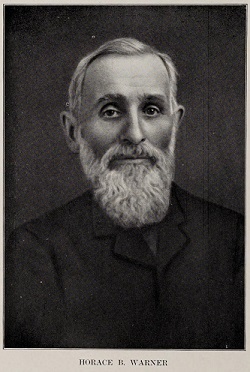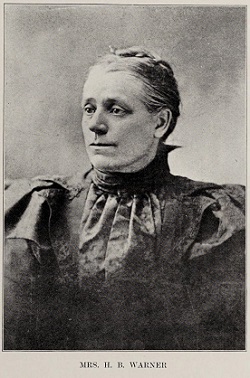
 One
of Macoupin county’s thrifty and capable agriculturists, now living
retired, is Horace Bascom Warner, of Chesterfield township. His birth
occurred at Vermontville, Michigan, on the 18th of October, 1842, his
parents being William Willis and Harriet Naomi (Bascom) Warner. The
father was born at Rutledge, Vermont, on the 19th of April, 1816, a son
of William and Nancy (Flail) Warner. The mother was a daughter of Joseph
Bascom, of Newport, New Hampshire, her natal day being the 26th of
November, 1821. Mr. Bascom, who was a tanner by trade, spent his last
years at Uxbridge, Canada, where he passed away in February, 1875. The
paternal grandfather, William Warner, was born in Vermont on the 6th of
May, 1769, and there he spent the early years of his life. His wife, who
bore the maiden name of Nancy Hall, died in that state. Subsequently he
joined a colony of Vermont people, who removed to Michigan, settling at
a place now known as Vermontville. There he entered government land, in
the cultivation of which he engaged until his death on the 12th of June,
1842. William W. Warner was married in Vermontville on the 26th of June,
1841, to Miss Bascom, and by this union eleven children were born, the
son Horace Bascom being the eldest of the family. The others in order of
birth are as follows: Joseph Edwin, who died in early youth; Mary
Abigail, the deceased wife of James Sackett, of Vermontville; Emma Jane,
the deceased wife of Bradley Willey, of Pewamo, Michigan; Asa John, who
is living in Vermontville; Charles Joseph, who is cultivating the old
homestead in Vermontville; Sarah Elizabeth, the deceased wife of Ernest
E. Rosekrans, of Auburn, Michigan; Ella Naomi, the deceased wife of Levi
Bottomley, of Chester, Michigan; William Willis, a resident of Saginaw,
Michigan; Harriet, the second wife of Ernest E. Rosekrans; and Luna A.,
who married Willey O. Hines, of Minneapolis, Minnesota.
One
of Macoupin county’s thrifty and capable agriculturists, now living
retired, is Horace Bascom Warner, of Chesterfield township. His birth
occurred at Vermontville, Michigan, on the 18th of October, 1842, his
parents being William Willis and Harriet Naomi (Bascom) Warner. The
father was born at Rutledge, Vermont, on the 19th of April, 1816, a son
of William and Nancy (Flail) Warner. The mother was a daughter of Joseph
Bascom, of Newport, New Hampshire, her natal day being the 26th of
November, 1821. Mr. Bascom, who was a tanner by trade, spent his last
years at Uxbridge, Canada, where he passed away in February, 1875. The
paternal grandfather, William Warner, was born in Vermont on the 6th of
May, 1769, and there he spent the early years of his life. His wife, who
bore the maiden name of Nancy Hall, died in that state. Subsequently he
joined a colony of Vermont people, who removed to Michigan, settling at
a place now known as Vermontville. There he entered government land, in
the cultivation of which he engaged until his death on the 12th of June,
1842. William W. Warner was married in Vermontville on the 26th of June,
1841, to Miss Bascom, and by this union eleven children were born, the
son Horace Bascom being the eldest of the family. The others in order of
birth are as follows: Joseph Edwin, who died in early youth; Mary
Abigail, the deceased wife of James Sackett, of Vermontville; Emma Jane,
the deceased wife of Bradley Willey, of Pewamo, Michigan; Asa John, who
is living in Vermontville; Charles Joseph, who is cultivating the old
homestead in Vermontville; Sarah Elizabeth, the deceased wife of Ernest
E. Rosekrans, of Auburn, Michigan; Ella Naomi, the deceased wife of Levi
Bottomley, of Chester, Michigan; William Willis, a resident of Saginaw,
Michigan; Harriet, the second wife of Ernest E. Rosekrans; and Luna A.,
who married Willey O. Hines, of Minneapolis, Minnesota.
The
early years of Horace Bascom Warner were spent on the Michigan homestead
in a manner very similar to those of other youths of the pioneer period.
After the completion of his public school course he entered Olivet
College, at Olivet, Michigan. While a student there the Civil war broke
out, and in common with many of his patriotic classmates he responded to
the nation’s call, enlisting in Company H, Fourth Michigan Volunteer
Cavalry. His regiment reported at Jeffersonville, Indiana, where they
were equipped for service, then joined the Army of the Cumberland under
General Buell in General Thomas’ corps. His first experience as a
soldier was obtained at Perryville, Kentucky, and later he participated
in the battles of Stone River, Chickamauga and Atlanta. His regiment
assisted in driving Hood’s army back into Tennessee and subsequently
spent four days in battle at Franklin, that state. They joined Wilson’s
Cavalry in their famous raid through Georgia and Alabama in 1865, and to
Mr. Warner belongs the distinction of having been a member of the corps
that captured Jefferson Davis. At Rome, Georgia, he was promoted to
corporal and two days later was made quartermaster sergeant. He was
mustered out at Nashville, receiving his discharge at Detroit.
Immediately following his return home he became a wage earner and for
two years worked by the month as a farm hand. At the expiration of that
period he went to Ottawa, Kansas, where he pre-empted land that he
cultivated for three years. He then came to Illinois to be married and
immediately returned to Kansas with his bride, settling in Sedgwick
county, in the vicinity of Wichita, where he homesteaded a quarter
section. In 1873 he returned to Illinois and operated rented land in
Chesterfield township, Macoupin county. This proved sufficiently
lucrative to enable him to later purchase a seventy acre tract adjoining
a piece of similar size presented to Mrs. Warner by her father. Here he
has since continuously resided, having, until his retirement, devoted
his attention to general farming and stock-raising. His farm is one of
the attractive places of the Challacombe settlement, so called from the
family that owns the majority of the land in the vicinity. His house
stands on the side of a hill overlooking the Macoupin creek, commanding
an extensive view of all the valley round with its well tilled fields,
green pastures, lanes and neat, substantial residences.
 On the
27th of October, 1870, Mr. Warner was married to Miss Isabella
Challacombe, who passed away on the 24th of December, 1904. Mrs. Warner
was born and reared in this locality, being a daughter of Nicholas
Challacombe, who is mentioned at greater length in the sketch of his son
John William Challacombe, which appears on another page of this work.
Four children were horn Mr. and Mrs. Warner: Hervey Edwin, living at
Challacombe, who married Florence Hartwell and has four children; Grace
Isabella, who died in infancy; Ray Elden, also a resident of
Challacombe, who married Harriet Richardson and has one child; and
Stella Naomi, who is unmarried and living at home.
On the
27th of October, 1870, Mr. Warner was married to Miss Isabella
Challacombe, who passed away on the 24th of December, 1904. Mrs. Warner
was born and reared in this locality, being a daughter of Nicholas
Challacombe, who is mentioned at greater length in the sketch of his son
John William Challacombe, which appears on another page of this work.
Four children were horn Mr. and Mrs. Warner: Hervey Edwin, living at
Challacombe, who married Florence Hartwell and has four children; Grace
Isabella, who died in infancy; Ray Elden, also a resident of
Challacombe, who married Harriet Richardson and has one child; and
Stella Naomi, who is unmarried and living at home.
Public
spirited in matters of citizenship, Mr. Warner always takes an active
interest in everything pertaining to his township, his political support
being given to the republican party. Although he has never figured
prominently in government affairs he has served as township collector
and assessor, efficiently discharging his duties. Those days of his
early manhood spent on the southern battlefields in the service of his
country are vividly remembered, the ties there formed being maintained
through the medium of his membership in the Grand Army of the Republic
at Piasa, his allegiance to which has ever been faithful After an
honorable youth and manhood he is passing life’s evening in the peace
aVid quiet justly merited by his well spent years, surrounded by his
children and grandchildren, one son and his family living on a farm
adjoining and the other but a short distance away.
Extracted 14 Nov 2018 by Norma Hass from History of Macoupin County, Illinois: Biographical and Pictorial, by Charles A. Walker, published in 1911, Volume 2, pages 284-290.